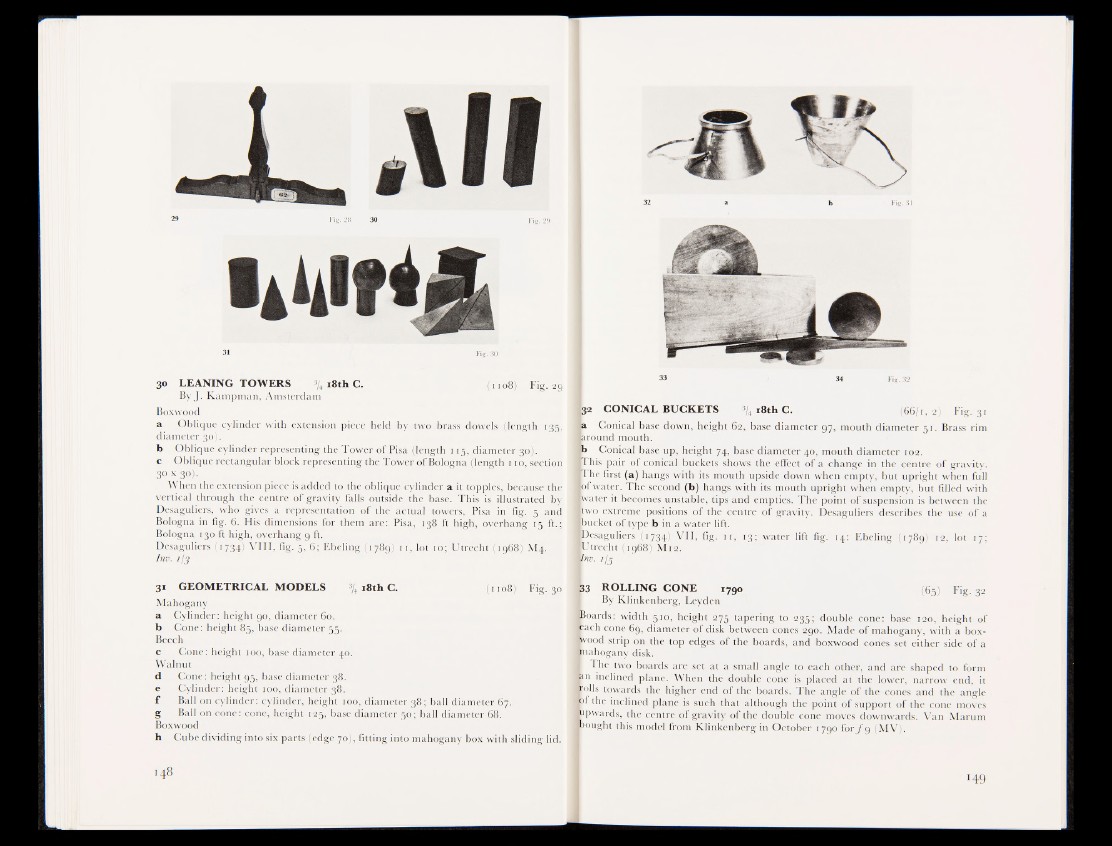
30 LEANING TOIVERS 18th C. j^^Biio8) Fig. 2g
By J. Kampman, Amsterdam
Boxwood
a Oblique cylinder with extension piece held by two brass dowels (length,
diameter 30}.
b Oblique cylinder representing the Tower of Pisa (length 115, diameter 30).
c Oblique rectangular block representing the Tower ofBoldgnamlength 110, section
30 x 30).
When the extension piece is added to the oblique, cylinder a it topples»ëcasù$e the
vertical through the centre of gravity falls outside the base. This is illustrated by
Desaguliers, who gives a representation of the actBil towers, Pisa iff fig. 5 and
Bologna in fig. 6. His dimensions for them are: Pisa, 138 ft high, overhang 15 ft.;
Bologna 130 ft high, overhang g ft.
Desaguliers (1734) VIII, fig,, 5, (i; Ebeling (1789) 11, lot iffi Utrecht (1968) M4.
Inv. i\3
31 GEOMETRICAL MODELS % 18th C. 108) Fig. 30
Mahogany
a Cylinder: height 90, diameter 60.
b Cone: height 85, base diameter 55.
Beech
c Cone: height 100, base diameter 40.
Walnut
d Cone: height 95, base diameter 38.
e Cylinder: height 100, diameter 38.
f Ball on cylinder: cylinder, height 100, diameter 38; ball diameter 67.
g Ball on cone: cone, height 125, base diameter 50; ball diameter 68.
Boxwood
h Cube dividing into six parts (edge 70^ fitting into mahogany box with sliding lid.
33 - 34 Fig. 32
I32 CONICAL BUCKETS % 18th C. (66/1,2) Fig. 31
a Conical base down, height 62^ base diameter 97, mouth diameter 51. Brass rim
»round mouth.
|b Conical base up, height 74, base diameter 40, mouth diameter 102.
■ This pair of conical buckets shows the effect of a change in the centre of gravity.
■ The first (a) hangs with its mouth upside down when empty, but upright when full
fcf water. The second (b) hangs with its mouth upright when empty, but filled with
■ water it becomes unstable, tips and empties. The point of suspension is between the
|wo extreme positions ©if the centre of gravity. Desaguliers describes the use of a
■ bucket of type b in a water lift.
MDesaguliers (1734) VII, fig. 11, 13; water lift fig. 14: Ebeling (1789) 12, lot 17;
■ Utretht (1968) M i2.
Vnv. 7 / 5
|33 ROLLING CONE 1790 • (65) Fig. 32
By Klinkenberg, Leyden
Boards: width gio, height 275 tapering to 235; double cone: base 120, height of
each cone 69, diameter of disk between cones 290. Made of mahogany, with a box-
rvo°d strip on the top edges of the boards, and boxwood cones set either side of a
Inahogany disk.
M e two boards are set at a small angle to each other, and are shaped to form
f n inclined plane. When the double cone is placed at the lower, narrow end, it
Bolls towards the higher end of the boards. The angle of the cones and the angle
pf the inclined plane is such that although the point of support of the cone moves
Jpwards, the centre of gravity of the double cone moves downwards. Van Marum
bought this model from Klinkenberg in October 1790 fo r/9 (MV).